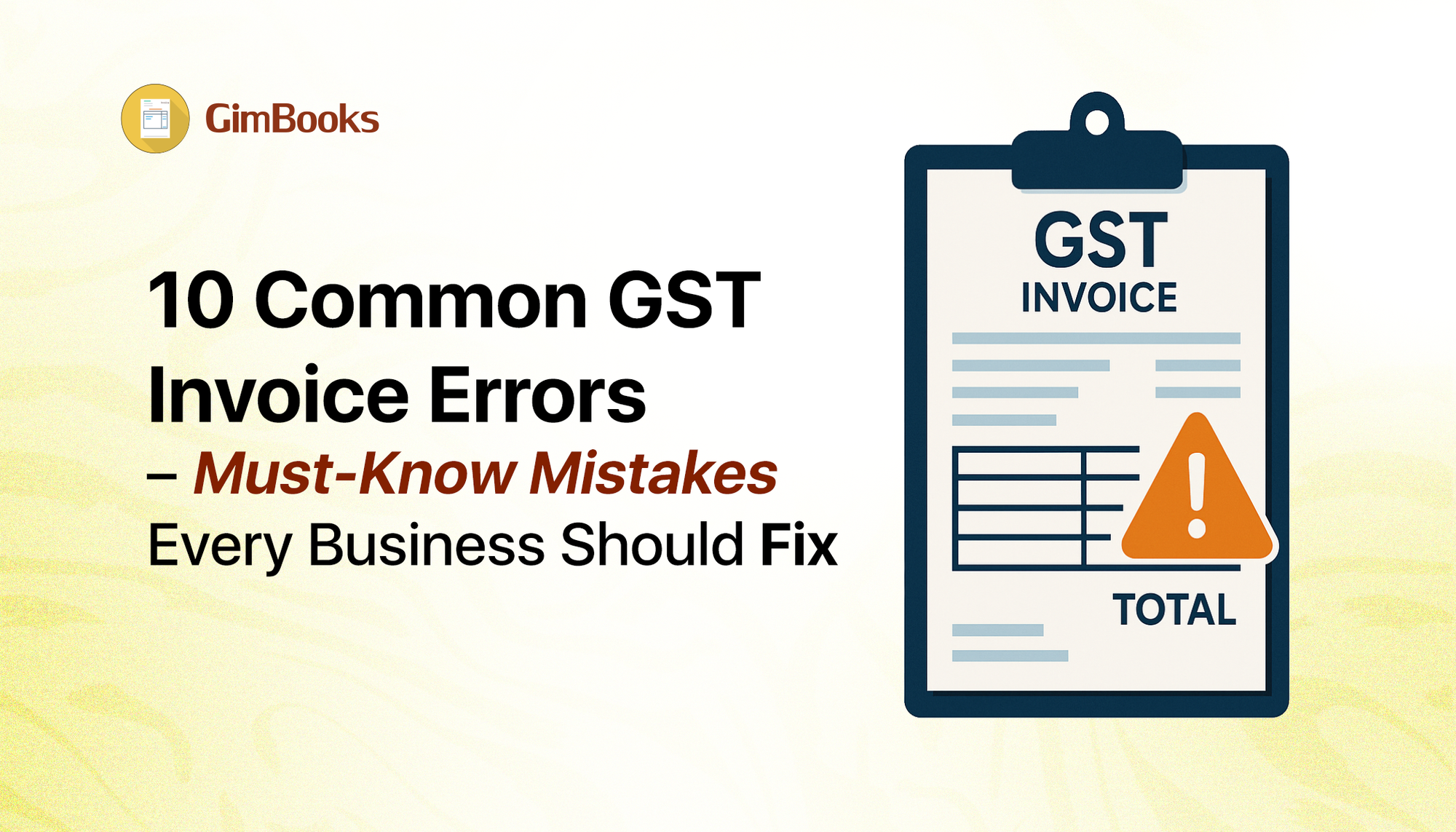10 Common GST Invoice Errors– Must-Know Mistakes Every Business Should Fix
Fix these GST invoice errors- Missing or Incorrect GST invoice error, manual Data Entry Error, Wrong tax rate applied, and more with GimBooks.

Why You Should Avoid GST Invoice Errors?
In India, GST Invoice errors can affect your business with inaccurate returns and bookkeeping records; accurate invoicing is non-negotiable. A simple mistake in your invoice can result in compliance issues, delayed ITC (Input Tax Credit), or even penalties. Whether you're a small business owner or a GST-registered company, it’s essential to be vigilant about how invoices are generated and maintained.
Here’s the deal: GST invoices are not just bills—they’re legal documents. If there are invoice errors, you’re not just irritating your buyer; you're putting your business at risk. Let’s look at the 10 most common GST invoice mistakes and how to avoid them.
Avoid these Top 10 GST Invoice Errors
1. Missing or Incorrect GSTIN
If you enter the wrong GSTIN or miss it, your customer can’t get Input Tax Credit, and you might get a notice from the GST office.
Quick tips: Heads up on GST invoices!
Always make sure to double-check the GSTIN before sharing an invoice.
Use GST invoicing software's auto-validation tools and keep a solid list of customers' GSTINs.
2. Wrong HSN / SAC codes
Also, remember to include the right HSN/SAC codes. Whether you need these codes depends on your sales. Get them wrong or miss them, and your tax returns could get stuck, or audits could be a pain.
Quick tips for avoiding HSN / SAC code errors in GST invoices:
Know the correct HSN/SAC codes for your products/services.
Use GST invoicing software that automatically applies the correct HSN/ SAC code.
3. Wrong Tax Rate Applied
Getting the CGST/SGST/IGST rates wrong messes up both your customer's taxes and your own GST returns. This creates issues during matching your GSTR-1 and GSTR-3B.
Quick tips to Avoid Tax Rate Mistakes:
- Double-check rates on the CBIC GST Rate Finder.
- Categorise products/services correctly to get the right rate.
- Set up an approval process for any rate changes.
4. Missing Mandatory Invoice Details
A GST invoice must contain the following key elements:
| Mandatory Details | Description |
|---|---|
| Invoice number & date | Unique, sequential number |
| GSTIN of supplier & recipient | Must be valid |
| Place of supply | Crucial for inter/intra-state tax |
| HSN/SAC codes | Depending on turnover |
| Tax amounts | CGST, SGST, IGST clearly specified |
Incomplete invoices can be considered invalid, resulting in the denial of ITC.
Quick tips to avoid GST invoice errors:
- Use a standardised invoice format.
- Use billing software that doesn't allow missing fields.
5. Invoicing After the Due Date
Delayed invoicing is another compliance red flag, especially in B2B transactions where Input Tax Credit timelines matter.
Quick tips to avoid invoice errors after changing invoice date:
- Set automated reminders for recurring invoices.
- Use e-invoicing software that notifies you about due dates.
6. Ignoring Reverse Charge Mechanism (RCM)
Failing to mention RCM applicability on the invoice can result in non-compliance. Under RCM, the receiver of goods or services pays GST.
Quick tips to avoid RCM errors in GST invoices:
Clearly mention "Tax payable under reverse charge" on relevant invoices.
Train your team on when RCM is applicable (like GTA services, legal services, etc.).
7. Using the Wrong Type of Invoice
GST has different invoice types, like:
- Tax Invoice
- Bill of Supply
- Receipt Voucher
- Refund Voucher
An incorrect invoice type can confuse both parties and affect GST returns.
Quick tips to avoid GST invoice errors:
- Know the difference between taxable and exempt supplies.
- Configure your software to issue contextual invoices.
8. Duplicate Invoice Numbers
Repeating invoice numbers can cause data mismatches during audits or return filing. Duplicate invoices are flagged during GST return matching, leading to potential notices.
Quick tips to avoid duplicate invoice error:
- Maintain auto-generated, sequential invoice numbers.
- Avoid using Excel for invoice management.
9. Mismatched Buyer and Seller Information
An incorrect business name, address, or GSTIN for the buyer or seller causes reconciliation issues. It impacts ITC claims, especially during GSTR-2A reconciliation.
Quick tips to avoid buyer and seller mismatch in GST invoice:
- Store verified buyer information in a customer master file.
- Sync buyer details from the GSTN database periodically.
10. Not Issuing Invoices for Advance Payments
Advance payments received must be invoiced even before the supply is made.
Non-compliance here is penalised during GST audits.
Quick tips to avoid advance payment-related GST invoice errors:
- Issue a Receipt Voucher for advances.
- Track partial payments and reconcile them against the final invoice.
4 Important Tips to Avoid GST Invoice Mistakes
- Cross-verify all fields before issuing.
- Keep templates aligned with the latest GST updates.
- Use invoice audit checklists monthly.
- Train your team on GST invoicing compliance.
How GST Software Can Help Avoid Errors
Modern GST billing software like GimBooks offers:
- Auto-fill GSTIN and buyer details
- Auto-apply HSN/SAC codes and correct tax rates
- Error checks before invoice generation
- Auto-reconciliation with GSTR returns
Expert quick tip:
If you're still using Excel or manual formats, it's time to upgrade. Online invoicing software ensures error-free compliance.
Conclusion for Fixing 10 Common GST Invoice Errors
GST invoice errors might seem small, but their impact can be huge—from ITC rejections to penalties and legal notices. The key is prevention. Use modern GST billing tools like GimBooks, stay informed about changing rules, and implement internal audits.
If you’ve made some of these mistakes before—don’t worry. Correct them now, keep your records clean, and stay 100% GST compliant going forward!
FAQs About Fixing GST Invoice Errors
1. What happens if there’s a wrong GSTIN on the invoice?
Your buyer won’t be able to claim ITC, and you might receive a GST notice for a mismatch.
2. Can I revise an already issued GST invoice?
Yes, but only within the same financial year using a credit or debit note.
3. How can software help reduce GST errors?
Good software validates GSTINs, auto-fills mandatory fields, and eliminates manual errors during invoice creation.
4. What if the HSN/SAC code is incorrect?
It can affect tax rate application and attract notices. Always cross-check codes based on CBIC updates.
5. Is it mandatory to issue a GST invoice for every sale?
Yes. If you're a registered taxpayer, GST invoices are required. For unregistered buyers, a Bill of Supply may be used depending on your turnover and the type of sale.
6. Can invoice errors lead to penalties?
Yes. Under Section 122 of the CGST Act, incorrect invoicing can lead to a penalty of ₹10,000 or the tax amount involved, whichever is higher.
